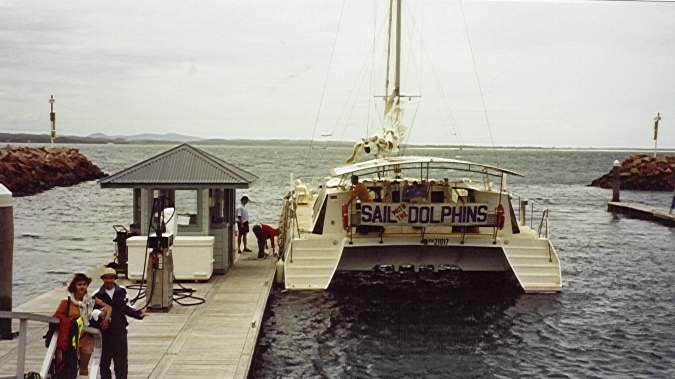
| "Imagine",
the boat we were sailing with. |
|
PORT STEPHEN.
From Port Stephen
is Olivia De Bergerac (founder of The Dolphin Society)
sailing out with the catamaran "Imagine". The
boat takes around 20 people, and Olivia makes over the
weekend what she calls "Dolphin Within"
program. I can recommend you to read Olivias book
"The Dolphin Within", where she writes
everything about the program.
Your brainwaves are measure before and after the trip
with a Neurodata 2000 EEG system. Our brainwave are
divided into Beta > 14 Hertz, produced by thinking,
stress and anxiety. Alpha 9 – 13 Hertz, relaxed,
passive and pleasant state. Theta 4 – 8 Hertz, light
sleep, "twilight state", state from where the
creative ideas are born, and Delta <4 Hertz normally
deep sleep. The pattern shows a clear tendency: After
"dolphintrip" the Beta is going down, the Alpha
and Theta is going up. You are more relaxed, more centre
and your whole body has better "working
condition".
|
Sad to
say, in practice the measurement was going so quickly, so
I don’t have a clear picture of what was happening
with my own brainwaves.
Olivia does not have personal contact with a group of
dolphins, so dolphinswim is more a "writing
way", than it is a practical reality. You will
nearly always see dolphins from the boat, but it is not
the same experience as meeting dolphins in the water.
The food on the boat was of a good quality and tasted
fine.
During the night you were either sleeping "packed
like sardines" under deck, or you were enjoying the
stars, the dark, the cold and the fresh air on top of the
deck.
I can say, if you have both enough time and money it is
fine to take that trip. |
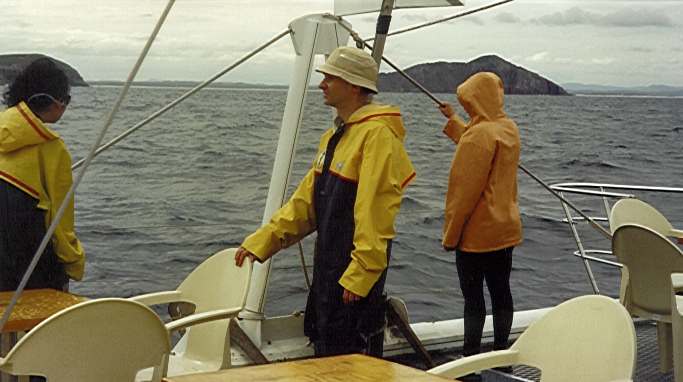 |
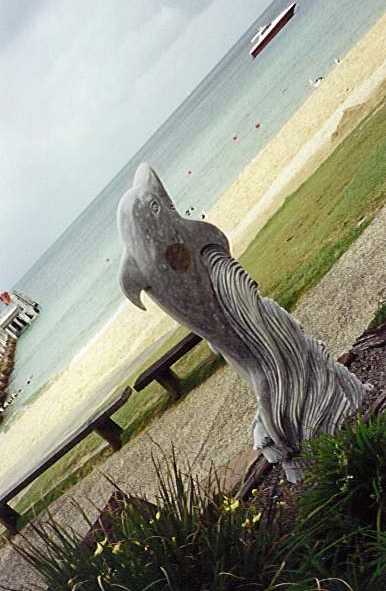 |
The beach at
Tangalooma, from where the dolphins are fed. The red buoy in the sea mark the
"feeding area" for the dolphins.
|
|
TANGALOOMA, MORETON
ISLAND
Wild Dolphin Resort
From Brisbane you
take "Tangalooma Flyer" to get to the Moreton
Island, it takes 70 minutes. You need to make reservation
for the boat, as well as for the popular "Dolphin
Feeding Program", which goes on every evening at
Tangalooma. For further information look at: www.tangalooma.com
The tourist with ticket for the feeding program is linen
on long rows, two and two on the small beach where the
dolphins are coming. Each person gets three fish and feed
the dolphins with one fish at a time. The roles for the
persons are:
No sharp hand jewellery.
No sun creme on.
No blitzphoto.
No cold or flu.
No touch of the dolphin.
The hands are disinfected just before you get fish in
your hands.
|
If all the dolphins are coming, which are seven to ten,
then around 100 people can feed them in one evening. The
dolphins get 10% of their daily food quantity. If they
got more, they would be too lazy to catch their own food.
The dolphin-provisioning program started in conjunction
with the University of Queensland in 1992.
It was an exciting experience to stay there on the beach
waiting for the dolphins to come. When the dolphins
started to come, it was like an energy change on the
whole place.
Trevor Hassard was telling about the place and the
dolphins, and also that they got many letters form people
telling them that they had been healed from the dolphins.
I remember he told about a Japanese lady with cancer in
abdomen. She came to the dolphins as her
"death-wish". She was in a wheelchair. She was
left rather long time in the water with the dolphins, one
dolphin, named Echo had his beak right in her sex, while
she was sitting in the water. Nobody knows what happened,
but the lady did not die. .
If you are near Brisbane, I can recommend taking the
morning boat to Tangalooma, and stay until the evening
boat, which sails back to Brisbane when the dolphins
leave the place.
|
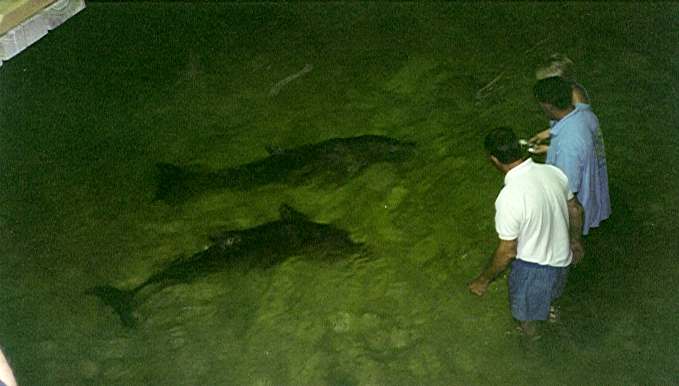
| An assistant from
Tangalooma and two tourist are feeding the
dolphins. |
|

| People
at Tin Can Bay are feeding the dolphins. |
|
TIN CAN BAY
Tin Can Bay is
situated 3 hours drive north of Brisbane. The seldom
dolphin called Indopacific humpbacked dolphin-Sousa
chinensis is living there in the shallow water. The
colour can vary from grey over white to pink. The
population in Tin Can Bay is only about 20. Normally they
are shy, and we don’t have much knowledge about
them.
Many years ago, around 1990, a shark attacked one of
those dolphins. Severely wounded the dolphin follow the
fishing boats to get some food. This dolphin was called
Scarry, it is a female. About April 1992 Scarry gave
birth to a male calf, called Mystique. Scarry was
bringing Mystique into the harbour, also to get easy
food. Soon it was known all over that two dolphins were
coming to be hand feed. Hundreds of tourists were coming
to look on, touch and swim with the dolphins.
There were no permit and no satisfactory management of
the Tin Can Bay dolphin-provisioning program. There were
poor control of fish quality and the condition of fish
containers, large number of people in the water, people
increasing their risk of injury by moving into deeper
water (shark attack), no control of food quantity,
feeding the calf and trying to ride him by holding onto
his dorsal fin. The result is that today Mystique has a
curved dorsal fin.
|
In May 1998 Pauline Norris came to Tin Can Bay with the
wish to protect the dolphins. Now the dolphins became
more a political question, and soon lots of fights were
going on. The dolphins were "good money" for
some people, and they still wanted the dolphin. The
government did not want to use time and money on the
dolphins, and at the same time they had to do something.
Over the last two years following rules has been
introduced:
No swimming.
No touching.
Only move into the water to your knee
The dolphins only get around 3 kg fish each, and only
once a day, it is between 8 – 11 am.
I had a lovely meeting with both Scarry and Mystique.
They are beautiful to look at, so if you are in the near
go and visit them. (but make sure they are still there,
call the Tourism Association (07) 5486 4855) |
 |
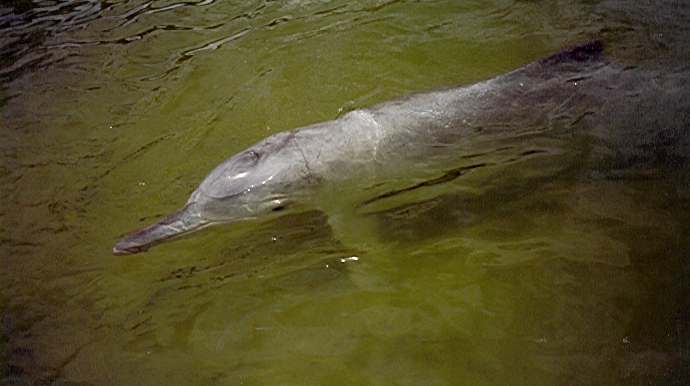 |
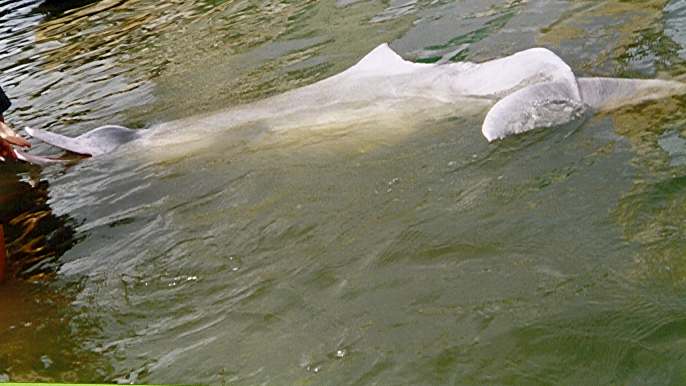 |







